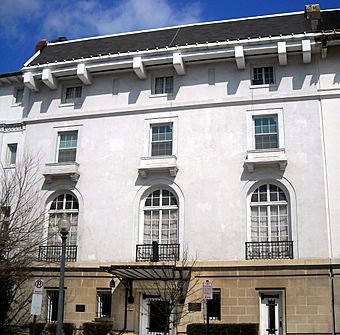Charles Evans Hughes House facts for kids
|
Charles Evans Hughes House
|
|
|
U.S. Historic district
Contributing property |
|
 |
|
| Location | 2223 R Street, NW Washington, D.C. |
|---|---|
| Built | 1907 |
| Architect | George Oakley Totten, Jr. |
| Architectural style | Mediterranean Revival Style |
| Part of | Sheridan-Kalorama Historic District (ID89001743) |
| NRHP reference No. | 72001424 |
Quick facts for kids Significant dates |
|
| Added to NRHP | November 28, 1972 |
| Designated NHL | November 28, 1972 |
| Designated CP | October 30, 1989 |
The Charles Evans Hughes House is a special old house. It is located at 2223 R Street, NW in Washington, D.C.. This house was built in 1907.
From 1930 to 1948, it was the home of Charles Evans Hughes. He was a very important politician. He was also the Chief Justice of the United States from 1930 to 1941. The house was named a National Historic Landmark in 1972. This means it is a very important historical place. Today, it is the official home of the Ambassador of Myanmar to the United States.
Contents
About the Charles Evans Hughes House
The Charles Evans Hughes House is in an area of Washington, D.C. called Embassy Row. This area has many embassies and official homes. The house is on the north side of R Street. It is between Sheridan Circle and 22nd Street.
What the House Looks Like
This house is one of two stone buildings. They are 3 and a half stories tall. They look like an Italian palazzo, which is a large, fancy building. The bottom floor is unpainted stone. It has a glass and iron cover over the main front door. There is also a smaller entrance on the right side.
The windows on the second floor are tall. They have rounded tops and small iron balconies. The windows on the third floor are rectangular. They have stone boxes underneath them.
History of the House
The house was built in 1907. It was designed by an architect named George Oakley Totten, Jr.. At first, it was used by different countries. For example, the missions from Peru and Chile used it.
In 1930, Charles Evans Hughes bought the house. He had just become the Chief Justice of the United States. He lived in this house from 1930 until he passed away in 1948.
Who Was Charles Evans Hughes?
Charles Evans Hughes (1862–1948) was a very important person in American history. He was a leader during the Progressive Era. This was a time in the early 1900s when people worked to fix problems in society.
He was a presidential candidate in 1916. He also served as an Associate Justice from 1910 to 1916. During this time, he often disagreed with the other judges. He held many important jobs for different Presidents. President Herbert Hoover chose him to be Chief Justice in 1930.
The House Today
In 1972, the country of Burma bought the building. Burma is now called Myanmar. The Charles Evans Hughes House is now the home of the Burmese ambassador.



